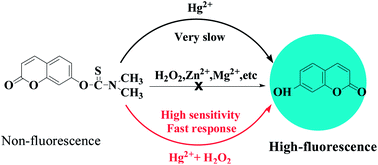Highly selective and sensitive fluorescent probe for the rapid detection of mercury ions
Abstract
Mercury (Hg) is one of the major toxic heavy metals, harmful to the environment and human health. Thus, it is significantly important to find an easy and quick method to detect Hg2+. In this study, we designed and synthesized a simple fluorescent probe with excellent properties, such as high sensitivity and selectivity, rapid response, and outstanding water solubility. When Hg2+ (5 μM) was added to the probe solution, it exhibited a very large fluorescent enhancement (about 350-fold stronger than the free probe) with the help of hydrogen peroxide (H2O2). Probe HCDC could quantitatively detect Hg2+ in the range of 0–10 μM using the fluorescence spectroscopy method and the detection limit was measured to be about 0.3 nM (based on a 3σ/slope). Analytical application was also studied, and the probe HCDC exhibited excellent response to Hg2+ with the addition of H2O2 in real water samples. So, our proposed probe HCDC provided a practical and promising method for determining Hg2+ in the environment.



 Please wait while we load your content...
Please wait while we load your content...